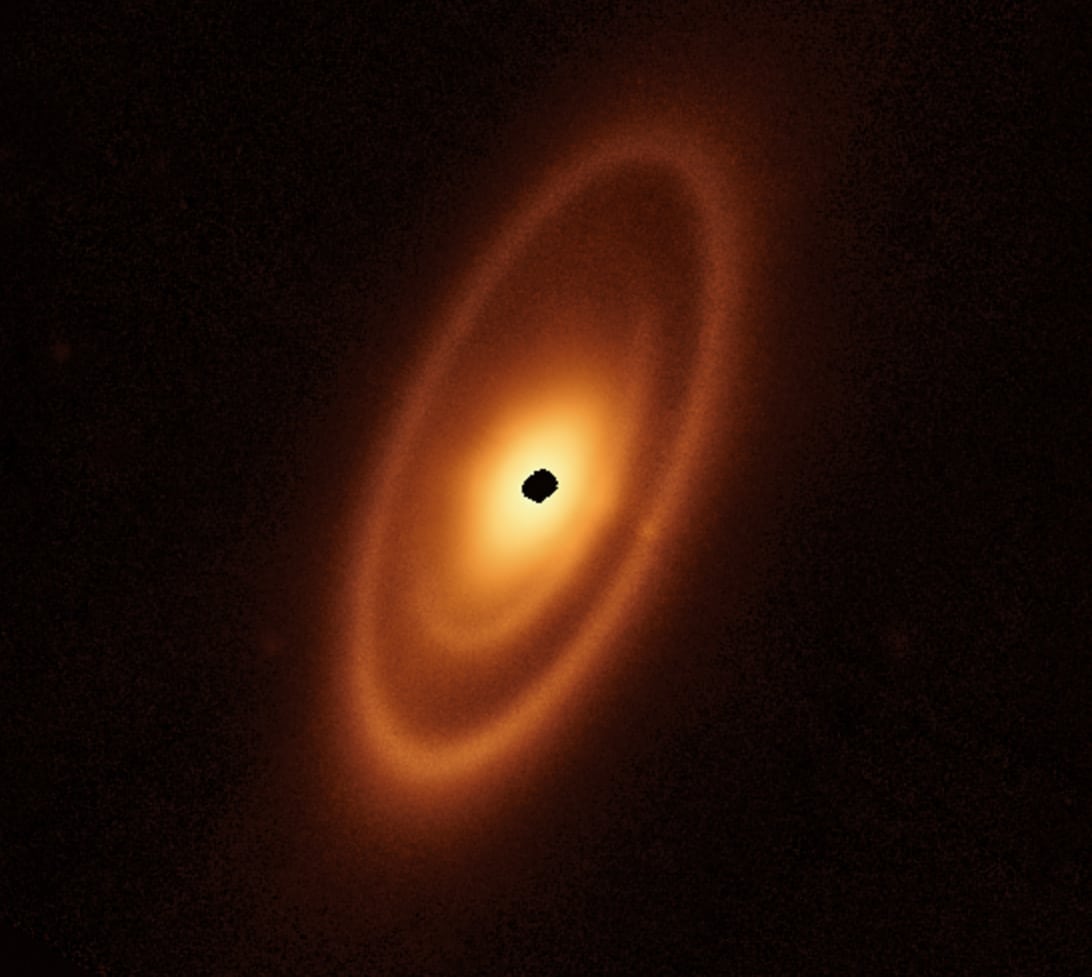(CN) — In a study released Monday in the academic journal Springer Nature, astronomers announced they had discovered a previously undetected debris field – and possibly a new planet – circling a star in our stellar backyard.
Known as Fomalhaut and located about 25 light years from Earth in the constellation of Piscis Austrinus, it's among the brightest stars in its patch of the sky. It's a young blue star, only about 440 million years old, that shines 16 times brighter than our 4.6-billion-year-old yellow dwarf sun with almost twice its mass and diameter.
Large Jupiter and Neptune-like planets – gas and ice giants, respectively – often circle young blue stars. Observations a team of researchers carried out last October, utilizing the infrared imaging capabilities of the James Webb Space Telescope, suggest Fomalhaut is no exception.
Scientists have known for more than a decade that Fomalhaut is encircled by an icy debris ring analogous to the Kuiper belt which orbits the sun. The new Webb images released in Springer Nature on Monday further revealed a series of concentric debris rings, with a hot inner disk and a previously undetected intermediate belt lying between it and the Kuiper belt analog, similar to the asteroid belt which separates the inner and outer planets of our solar system.
As in our solar system, wide gaps between these debris belts suggest their distinct orbits are maintained by the gravity of planets. András Gáspár, a professor of astronomy at the University of Arizona and one of the study's authors, said scientists had already suspected the presence of two Neptune-like planets supporting Fomalhaut's Kuiper belt analogue. The newly discovered intermediate belt, he said, likely has its own planetary shepherd.
"Previous papers... estimated the outer Kuiper belt [analog] to be shepherded by two smaller ice giants," Gáspár said in an email to Courthouse News. "The newly discovered intermediate gap is also likely shepherded by such a smaller gas giant; larger planets would disrupt the structure on a short timescale."
Scientists also once suspected that another object orbiting Fomalhaut, known as Fomalhaut b or Dagon, was a planet. But observations made using the Hubble Space Telescope in the early-mid 2010s suggested that it was instead a debris cloud making its exit from the system, possibly the result of a planetary collision. Compared to a single, stable planetary body, Fomalhaut b was too bright in scattered visible light, too dim in the infrared spectrum, and seemed to be expanding. The latest observations made using the more advanced Webb telescope, Gáspár said, only supported that conclusion.
"All three of these observables hinted at the dust we see leaving the system and expanding in size, indicative of a collisional cloud," Gáspár said. "The new observations... further strengthen this model, establishing a dynamically active and densely populated area where we think the collision occurred that produced the Fomalhaut b object. This was the missing weak link in the model, as collisional probabilities otherwise would be low in a relatively empty area."
Despite this evidence of active collisional activity and Fomalhaut's young age, Gáspár warned against comparing the star's debris rings with the protoplanetary disks which circled the sun in its own infancy. Unlike those disks, from which the Earth and the other planets in our solar system condensed, Gáspár said Fomalhaut's debris rings had almost no gasses like carbon dioxide.
"The disk system we see is mature and almost completely lack of gas [sic], unlike a gas-rich protoplanetary disk... What we see is the micron sized dust particles originating from the collisions within the disk," Gáspár said.
Given this lack of gas, Fomalhaut's young age and the fact that blue stars of its kind generally do not live longer than a billion years, Gáspár said any planets shepherding Fomalhaut's debris rings are unlikely to have conditions favorable to the evolution of life. But he added that detecting a new intermediate ring around Fomalhaut, and a likely planet shepherding it, is still a significant discovery.
It's the first time, he said, that scientists have been able to map an extrasolar debris field analogous to the asteroid belt between Mars and Jupiter.
"This is the first time we were able to spatially resolve and characterize an asteroid-belt analog region around any star! Practically, all debris disk observations that are spatially well characterized have been of cold Kuiper-belt analog rings," Gaspar said.
Subscribe to Closing Arguments
Sign up for new weekly newsletter Closing Arguments to get the latest about ongoing trials, major litigation and hot cases and rulings in courthouses around the U.S. and the world.









